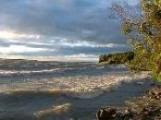LSRCA tests product that could solve phosphorus problems
Andrew Wink of Phoslock Water Solutions, was spraying the sample of the material into the stormwater management pond next to the Newmarket municipal offices. Photo by Bill Rea The Lake Simcoe Region Conservation Authority are hoping it is the solution to the phosphorous problem in Lake Simcoe.
Phosphorus has been a problem in fresh-water lakes for years, including Lake Simcoe.
Officials with the Lake Simcoe Region Conservation Authority (LSRCA) think they have found a method to deal with it, and the province has put up $250,000 to try it out.
LSRCA hosted a demonstration Thursday outside the municipal offices in Newmarket, in which a quantity of the product, called Phoslock, was applied to a stormwater management pond outside the building.
Mike Waters, director of watershed management for LSRCA, explained Phoslock is made from a modified clay, combined with lanthanum, which adheres to and binds with the phosphorus and holds it down. Once it's on the bottom, it forms a fine layer of sediment that traps other phosphorus, thus preventing it from being a nutrient for plants and algae.
LSRCA Chair Virginia Hackson commented phosphorus ends up in the lake and the 18 tributaries flowing into it. It comes from surface water that flows through such things as farm fields, treatment plants septic systems, etc. Unnaturally high concentrations in the lake have caused excessive growth of certain plants and algae. When they die, they decompose at the bottom of the lake, and Hackson said that uses up oxygen. She explained that forces young cold water fish, like lake trout into shallower waters, thus closer to their predators.
"We believe Phoslock shows great promise," Hackson said, adding it's been demonstrated that it can remove up to 95 per cent of the phosphorus from the water.
She also said the product has been used widely in Australia, United Sates, China and Europe.
Oakville MPP Kevin Flynn, parliamentary assistant to Environment Minister John Gerretsen, said the government's support of this project is a sign of how important it considers the protection of Lake Simcoe.
"It's just a small part of what we're doing in the Simcoe watershed," he remarked.
He also said he has a personal connection with matters like this, recalling his time as a Regional councillor in Halton, and they were having trouble dealing with the smells coming from the algae in Lake Ontario. They tried several methods, and Flynn said he even headed up a committee formed to seek input on the matter.
"This is a little bit more than a job here for me today," he remarked.
He added the government plans to continue looking for innovative and scientific ways to deal with the contaminants in the lake, and that includes looking into climate changes, population growth, invasive species, etc. "We're going to continue to listen to the experts and the people who care about the lake," he declared.
"We're glad that you showed up with a cheque," quipped Newmarket — Aurora MPP Frank Klees.
He also commended LSRCA for the work its been doing and the progress that has been made in cleaning up the lake. "We have a great deal to be thankful for," he commented.
Klees also praised LSRCA CAO Gayle Wood, for learning about Phoslock on a trip to Australia and employing the "best practices" concept to get it tried here.
Ontario Environmental Commissioner Gord Miller was on hand for the demonstration, and reflected that it took several years for people to get the idea that phosphorus is what causes algae, although he pointed out it was accepted by the late 1960s, around the time they started banning phosphates from detergents. But he added it's still a problem.
"It's really, really important that we solve this problem," he declared. "Lets' give this a try and let's be successful."
Eddie Edmunds, chief operating officer of Phoslock Water Solutions of Sydney, Australia, said this material has been used successfully in about 20 countries, adding it's been determined that it's both cost-effective and safe. He also said demand for it has been increasing, which he said is a sign that it's meeting expectations.
King Councillor Jack Rupke, who also sits on LSRCA, was hopeful Phoslock can be applied where it's needed most in the watershed, and "that's basically the river running through the Holland Marsh."
He added the Ministry of the Environment wanted proof that it wasn't going to be a detriment to anything. "That's why we're here," he remarked.
York — Simcoe MPP Julia Munro thought the demonstration showed a couple of things. One is the leadership being shown by LSRCA and the way it looks for best practices to employ. She also said the phosphorus is one of the problems that alerts to other issues in terms of water quality.



